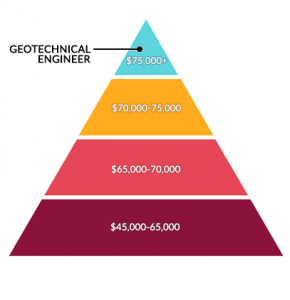6 Easy Facts About Geotheta Shown
6 Easy Facts About Geotheta Shown
Blog Article
Geotheta - An Overview
Table of ContentsGeotheta for Dummies8 Simple Techniques For GeothetaThe Facts About Geotheta UncoveredThe 5-Minute Rule for Geotheta
They collaborate with civil engineers, structural engineers, designers, and various other professionals to incorporate geotechnical considerations right into the total job style and construction procedure. This needs efficient teamwork, coordination, and communication to make sure that the geotechnical elements line up with the job objectives and meet regulative demands.Mining & Materials Design: Principles of exploration, penetration rates, and variables affecting the selection of exploration approach. Blowing up techniques in surface area and underground workings. Mechanical and continuous strategies to fragmentation, including longwall shearing and fullface boring.
Modelling of fragment and fragment size circulations; comminution as a transfer function. Comminution technology: crushing, grinding, size category. Integrated analysis of fragmentation and comminution procedures. Provided by: Mining & Materials Engineering.
Geotheta - An Overview
Bachelor's level programs in civil, geotechnical, geological, and environmental design typically last four years and include basic education training courses in English, social scientific research, and the humanities, along with training courses in innovative maths, architectural geology, and fluid mineralogy. (https://canvas.instructure.com/eportfolios/3071866/Home/Why_Geotechnical_Engineers_Are_Essential_for_Your_Construction_Projects)
Geotechnical engineering involves the assessment of the dirt and rock conditions at a specific site, and their implications for the development of that site. As a lot of structures count on the ground for assistance, it is without surprise that a comprehensive understanding of the ground conditions, and the viability of structure systems, are important to the long-lasting stability and efficiency of the structure or framework.
Being experts in the examination of geological developments and ground behaviour, geotechnical designers do clinical examinations and screening to comprehend the influence these geological formations may have on the style and building and construction of structure, civil and facilities tasks. This proficiency is vital for the design and building and construction of buildings, roads, tunnels, dams, bridges, and water and sewer systems.
The geotechnical group at Douglas Allies regularly consult with designers, layout engineers, designers, and builders to make suggestions on style and advancement proposals to make sure that the constructed structures are appropriately made for the ground problems. The style of footing systems needs to think about the weight of the framework, the ability of the ground to sustain that weight together with movement resistances and effective construction.
Not known Facts About Geotheta
This task is considerably streamlined by the use our Douglas Map geospatial platform which makes this details conveniently easily accessible in a very easy to utilize web internet browser interface. A geotechnical designer will route the exploration of boreholes and examination pits to accumulate dirt and various other examples, and also assess surface area attributes and ground direct exposures to form a geotechnical version of the subsurface conditions.
Depending on the task type and ground conditions encountered, lab screening might to name a few points examine strength, compressibility, reactivity and/or permeability of dirt and rock samples. Hereafter data is collected and collated, the results are utilized for a geotechnical design of the site, which is generally presented as sections across the website.

A geotechnical investigation by nature can only analyze the ground conditions at the areas drilled or excavated. Natural variations in dirt and rock conditions can take place throughout a site and in between test locations. It is for that reason excellent practice that the geotechnical designer be maintained throughout building of the job to provide on-site verification that the ground conditions experienced are regular with the expectations and recommendations offered in the geotechnical examination report.
Geotheta Fundamentals Explained
Geotechnical engineers utilize their extensive expertise of dirt and rock to analyze danger and solve issues on varied infrastructure projectsGeotechnical engineering is a specialist branch of civil engineering which considers the practices of earth materials and the application of soil and rock mechanics. Geo Tech Engineering. As a geotechnical engineer, you will analyze the physical, mechanical and chemical homes of dirt and rock in order to design foundations, retaining frameworks and earthworks
Geotechnical design is closely connected to and overlaps with, both design geology and ground design - https://telegra.ph/Why-Geotheta-is-Your-Go-To-for-Geotechnical-Engineers-in-South-Africa-08-02. It's feasible to be experts in geotechnics or work for a geotechnical firm however be known as a design rock hound or a ground designer. As a geotechnical engineer, you'll need to: build and keep connections with customers and various other specialists involved in the website, throughout each projectmaintain safety criteria on website be mindful of price effects when you make recommendationsstudy geological maps and aerial pictures from a series of resources and from different time periodsexamine building and construction plans to see just how feasible they are based on your understanding of the siteinvestigate threats or geological threats for the sitesearch for eco sensitive functions, such as landfill beginning to establish factual and interpretive ground modelsplan field investigationsdrill and analyse examples of bedrock, soil, groundwater and extra products oversee other specialists on sitesolve technological problems as they develop, such as unanticipated frameworks at drill sitesmonitor conditions during and after construction to see to it frameworks are secure in the short and lengthy termadding data accumulated on site to your initial researchcreating geotechnical calculations, drawings, and two or three-dimensional computer system models analyzing the datamaking suggestions about the proposed use the site

Report this page